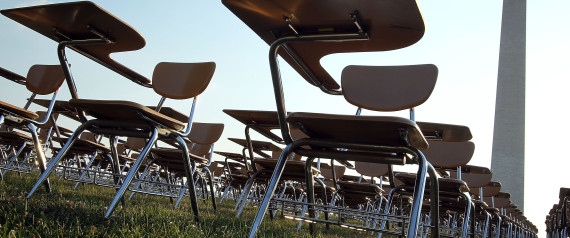School Absence Can Set Students Back Between 1 And 2 Years: Report
 |
| An installation of 857 empty school desks, representing the number of students nationwide who are dropping out every hour of every school day, is on display at the National Mall June 20, 2012 in Washington, D.C. (Photo by Alex Wong/Getty Images) | Alex Wong via Getty Images |
As the debate rages about the best way to fix America's public schools -- from heated rhetoric on the role of standardized testing to wonkier discussions about the intricacies of curricula -- a new report is arguing that reformers have overlooked a game-changing solution: addressing absenteeism.
While it may seem obvious that students who miss more school would not perform as well as other students, a new report released Tuesday shows just how much of a difference attendance can make. According to the report, written by nonprofit advocacy group Attendance Works, about 1 in 5 American students -- between 5 million and 7.5 million of them -- misses a month of school per year. The report suggests that missing three or more days of school per month can set a student back from one to two full years of learning behind his or her peers.
"All our investment in instruction and Common Core and curriculum development will be lost unless kids are in school to benefit from it," said Hedy Chang, the group's director and co-author of the report.
And for the many American students who have disabilities, the stakes are higher. In fourth-grade reading, the scores of students with disabilities showed more sensitivity than those of students without disabilities who had an equivalent number of absences, according to data the group analyzed exclusively for The Huffington Post. That population also registers more absences than their peers overall, despite needing more attention.
"Nobody likes to publicize this stuff unless they're doing well," said lead author Alan Ginsburg, a former director of Policy and Program Studies with the U.S. Education Department, "but these are big differences, and it should be on the front burner."
The new study used survey data from the 2013 National Assessment for Education Progress, a standardized test administered by the federal government, to compare students' absence rates with their performance. Students who took NAEP were asked whether they missed no days, one to two, three to four, five to 10, or more than 10 days of school over the last month.
Predictably, the students who missed the most school -- particularly those absent for three or more days in the last month, the report's definition of poor attendance -- had the lowest test scores. "This is true at every age, in every subject, in every racial and ethnic group and in every state and city examined," according to the report. "While students from low-income families are more likely to be chronically absent, the ill effects of missing too much school hold true for all socio-economic groups."
The report also examined absenteeism at the state level, finding that in the two states with the highest rate of absenteeism, Montana and New Mexico, a quarter of fourth-grade public school students reported missing three or more days in the previous month. Among large urban school districts, rates of absenteeism were highest in Detroit, Milwaukee and Washington, D.C.
In fourth-grade reading, students who missed three or more days per month scored School Absence Can Set Students Back Between 1 And 2 Years: Report:
